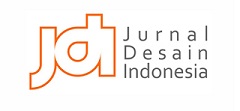SUNDEL: REINTERPRETASI BUNGA SEDAP MALAM DALAM MOTIF BORDIR DAN SULAM
Abstract
The making of embroidery and needlework motifs on art-wear that inspired from Sedap Malam (Sedap Malam) is the attempt to create an exclusive embroidery and needlework motifs as the identity of Pasuruan Regency, East Java. The creation of this motifs is the response from the need to develop, enrich, and design an embroidery and needlework motifs belongs to Pasuruan that would boost the sustainability of embroidery and needlework industry that is lately decreasing. Therefore, an experiment method in the form of innovative re-production is required to create an art-work with re-interpretation concept. The method in art creation used in this study is artistic research where the artist undergo several practices or creating process in the field study with emic approach, In this case, the process are developing the local potential in Pasuruan Regency (Sedap Malam) and identify what and how meaning inside it. The creation sages consist of data collection from various resources like field data and direct observation on Sedap Malam, literary study, and extensive interview with Tourism and Culture Department of Pasuruan Regency. The next stage is experimenting tuberose motif using reinterpretation concept. The motifs created during the experiment are stillation of Sedap Malam as the main motif, as well as complementary motifs generated from flora in the surrounding such as pandan leaves and rose balsam flower as the flower commodity in Pasuruan Regency. The inspiration in using Sedap Malam in creating embroidery and needlework motif on ready to wear results to ready to wear design with Sedap Malam motif that is made using embroidery and needlework technique, where Sedap Malam is presented as the main motif in the ready to wear.
Keywords
Full Text:
PDF (Bahasa Indonesia)References
Bircan, I., & Gencler, F. (2015). Analysis of Innovation Based Human Resources for Sutainable Development. Journal of Procedia Social and Behavioral Sciences 195, 1348-1354.
Djelantik, A. (1999). Estetika. Bandung: Masyarakat Seni Pertunjukkan Indonesia.
Feldman, E. B. (1967). Arts As Image and Idea. New Jersey: Prentice-Hall, Englewood Cliffs.
Gustami, S. (2004). Proses Peciptaan Seni Kriya”Untaian Metodologis. Yogyakarta: Program Penciptaan Seni Pascasarjana ISI Yogyakarta.
Hidayati, N. (2019). Women in Fashion: Preference and Existence of Handmade Fashion Products. International Journal of Innovation, Creativity and Change 8(1), 221-237.
Hidayati, N., Kiranantika, A., & Pujirahayu, S. E. (2019). The Identification of female workers in Handcraft Embroidery Industry Based on The Factors Shaping Their Work Behavior. Advances in Sosial Science, Education and Humanities Research, Volume 242 2nd ICOVET. Proceedings of the 2nd International Conference on Vocational Education and Training (ICOVET 2018). Amsterdam: Atlantis Press.
Kartika, D. S. (2016). Kreasi Artistik: Perjumpaan Tradisi Dan Modern Dalam Paradigma Kekaryaan Seni. Surakarta: Citra Sains.
Lestari, A. D. (2021). Tinjauan Pemanfaatan Limbah Kulit Jagung pada Produk Fashion. Narada Jurnal Desain dan Seni, 8(1), 31-44.
Lestari, N. S. (2013). Motif Bunga Dalam Kain Batik, Motif Cantik Yang Memikul Nilai Kekuatan Sakral Dalam Kehidupan Manusia. Prosiding The 5th International Conference on Indonesian Studies: “Ethnicity and Globalization" (p. 117). Yogyakarta: Fakultas Ilmu Pengetahuan Budaya Universitas Indonesia.
Odabasi, S. (2015). A Design Method On Wearable Art. Between Worlds Innovation and Design in Textiles and Costume. Turkey: Published in International Textiles & Costume Congress (ITCC).
Paramadhyaksa, I. N. (2016). Filosofi Dan Penerapan Konsepsi Bunga Padma Dalam Perwujudan Arsitektur Tradisional Bali. Jurnal Langkau Betang, 3(1), 28-42.
Prahardini, P. (2006). Teknologi Produksi Bunga Sedap Malam. Jurnal Info Teknologi Pertanian No: 52, 1-8.
Soedarso , S. (2006). Trilogi Seni: Penciptaan, Eksistensi, dan Kegunaan Seni. Yogyakarta: Institut Seni Indonesia.
Sugiharto, B. (2009). Untuk apa seni? Bandung: Matahari.
Sumardjo, J. (2006). Estetika Paradoks. Bandung: Sunan Ambu Press.
Suzana K, L. (2006). Problematika Seni. Bandung: Sunan Ambu Press.
DOI: http://dx.doi.org/10.22441/narada.2023.v10.i1.006
Refbacks
- There are currently no refbacks.
Fakultas Desain dan Seni Kreatif
Universitas Mercu Buana
Gedung E Lantai 4
Jl. Raya Meruya Selatan no.1, Kembangan, Jakarta 11650
Tlp./Fax: +62215871335
Journal International Standard Serial Number (ISSN) Registration:
The Journal is indexed by:
Tools for Citations & Plagiarism Detection:

Ciptaan disebarluaskan di bawah Lisensi Creative Commons Atribusi-NonKomersial 4.0 Internasional
 NARADA: Jurnal Desain dan Seni
NARADA: Jurnal Desain dan Seni

























